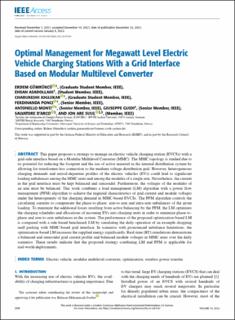| dc.contributor.author | Gümrükcü, Erdem | |
| dc.contributor.author | Asadollahi, Ehsan | |
| dc.contributor.author | Joglekar, Charukeshi | |
| dc.contributor.author | Ponci, Ferdinanda | |
| dc.contributor.author | Monti, Antonello | |
| dc.contributor.author | Guidi, Giuseppe | |
| dc.contributor.author | D'Arco, Salvatore | |
| dc.contributor.author | Suul, Jon Are Wold | |
| dc.date.accessioned | 2022-03-07T14:48:43Z | |
| dc.date.available | 2022-03-07T14:48:43Z | |
| dc.date.created | 2021-12-30T09:00:39Z | |
| dc.date.issued | 2021 | |
| dc.identifier.issn | 2169-3536 | |
| dc.identifier.uri | https://hdl.handle.net/11250/2983546 | |
| dc.description.abstract | This paper proposes a strategy to manage an electric vehicle charging station (EVCSs) with a grid-side interface based on a Modular Multilevel Converter (MMC). In such a system, heterogeneous behavior of electric vehicles (EVs), that is independent arrivals-departures and different load demands, could lead to significant loading unbalances among the MMC arms and among the modules of a single arm. Nevertheless, the current in the grid interface must be kept balanced and sinusoidal. Furthermore, the voltages of the modules of an arm must be balanced. This work combines a load management (LM) strategy with a power flow management (PFM) algorithm to achieve the required characteristics of grid current and module voltages despite the internal unbalances of an MMC-based EVCSs. The LM optimizes the charging schedules and allocations of incoming EVs into charging units in order to minimize phase-to-phase and arm-to-arm unbalances in the system. The PFM algorithm controls the circulating currents to compensate the phase-to-phase, arm-to-arm and intra-arm unbalances of the given loading, which is determined by the LM strategy. The performance of the proposed optimal LM is compared with a benchmark LM that controls the system load without optimizing charging schedules and allocations of the EVs by simulating the daily operation of an example shopping mall parking with MMC-based grid interface. The results show how the optimal LM decreases the phase-to-phase and arm-to-arm unbalances. In scenarios with pronounced unbalance limitations, optimal LM increases supplied energy significantly. Real-time (RT) simulations are performed to observe grid current and module voltage profiles of the daily scenario in high resolution. The results demonstrate a balanced and sinusoidal grid current profile and balanced module voltages in MMC arms, and indicate that the proposed strategy combining LM and PFM is applicable for real-world deployments. | en_US |
| dc.language.iso | eng | en_US |
| dc.publisher | Institute of Electrical and Electronics Engineers (IEEE) | en_US |
| dc.rights | Attribution-NonCommercial-NoDerivatives 4.0 Internasjonal | * |
| dc.rights.uri | http://creativecommons.org/licenses/by-nc-nd/4.0/deed.no | * |
| dc.title | Optimal Management for Megawatt Level Electric Vehicle Charging Stations with a Grid Interface Based on Modular Multilevel Converter | en_US |
| dc.type | Peer reviewed | en_US |
| dc.type | Journal article | en_US |
| dc.description.version | publishedVersion | en_US |
| dc.source.journal | IEEE Access | en_US |
| dc.identifier.doi | 10.1109/ACCESS.2021.3137544 | |
| dc.identifier.cristin | 1972881 | |
| cristin.ispublished | true | |
| cristin.fulltext | original | |
| cristin.qualitycode | 1 | |

